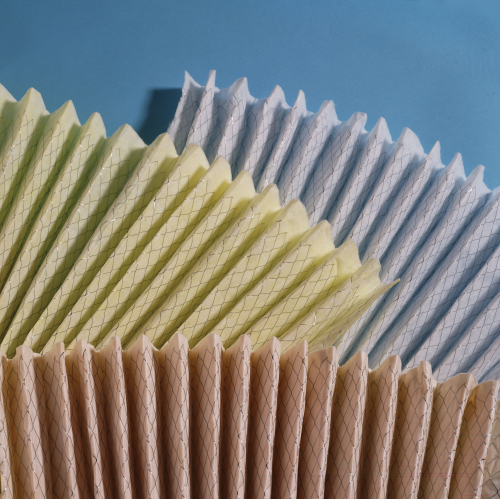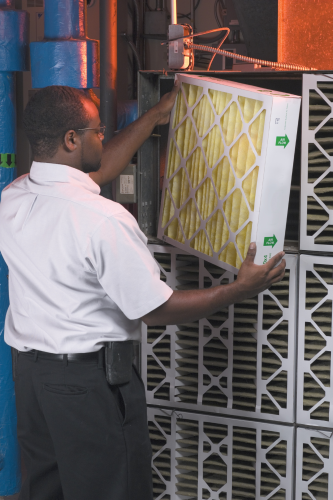

The North American air filtration industry has evolved tremendously since the introduction of the first air filters in the 1930s. The process of selecting air filters and air filter media has evolved as well. Today, it takes into account more than just protecting HVAC equipment; it also involves protecting building occupants, reducing energy consumption and minimising impacts on the environment.
Now, with a variety of filtration technologies and styles from which to choose and industry-standard criteria by which to judge filtration performance, it's possible and practical to specify air filters with filter media designed to maintain HVAC system cleanliness, improve indoor air quality, and reduce energy consumption simultaneously. Attention to the entire lifecycle cost of filters, and not just their initial purchase price, is crucial.
A brief history
Air filters were initially developed in the 1930s for use in the forced-air heating systems that became popular in the North American commercial buildings of the time. They were primarily designed to reduce the risk of building fires by protecting the systems' heating elements from dust. Air filters manufactured during this time period consisted of loose mats of fibrous glass, animal and synthetic fibers, metal mesh, and various fabrics of cellulose and other porous materials. These filters provided very low filtration efficiency.
In the 1940s and 1950s, as air-conditioning systems became more prevalent in commercial buildings, filters began to be used more for HVAC system hygiene — to protect cooling coils from dust, and thus prevent fouling. These filters were made with the same filtering materials used in the industry's earliest filters and also provided very low filtration efficiency.
In the 1980s and into the 1990s, public concerns over indoor air quality (IAQ) began to emerge. At this time, the industry started looking at the ability of filters to not only protect HVAC equipment, but also to clean the air stream for building occupants. Filtration technology continued to evolve with advances in filter media and the development of new styles and types of filters. During this time period, the industry also developed standard test methods for testing filtration efficiency. With the advent of the ASHRAE Standard 52.2, MERV (Minimum Efficiency Reporting Value) became the accepted reporting value in North America for which to compare filtration efficiency over a range of particle sizes.
Today, air filtration has evolved even further. Fuelled by various Green Building initiatives and rising energy costs, filter purchasers in commercial and institutional facilities especially are casting a more critical eye toward the role that air filters play in energy conservation, sustainable building design, and occupant health and productivity. In the United States, the terrorist attacks of September 11, 2001 have also created a focus on using air filters as a protection mechanism against chemical or biological attacks. Key drivers for the growth of the North American air filtration market include:
- • Indoor air quality — this is a significant problem in the commercial real estate market, where one of the top office building tenant complaints is poor indoor air quality and the consequential worker productivity reductions. It is also a concern in educational facilities, where researchers are beginning to link student absenteeism to poor IAQ.
• Hospital acquired infections — controlling dust and microbial contamination has always been a concern in healthcare facilities. Now, the healthcare industry is beginning to study the potential link between facility HVAC and plumbing systems and nosocomial (hospital-acquired) infections.
• Energy Savings — HVAC system designers are looking at air filtration systems that deliver increased filtration performance while keeping energy consumption low, as energy costs are expected to continue rising over the next several years. HVAC filters can be an effective energy conservation tool since more than 60 percent of an average facility's energy usage comes from the HVAC system. This is prompting facility managers and their HVAC contractors to seek filters with less resistance to airflow, which helps HVAC system motors run more energy-efficiently.
• Sustainability — good IAQ is a key tenet of many Green Building programs, and organisations are increasingly concerned with making themselves more sustainable for future generations. In addition to energy savings, and the corresponding reduction in greenhouse gas emissions, the right air filter media can provide other sustainability advantages relating to waste reduction and raw material usage.
Filter technologies and filter styles
There are many styles of HVAC filters on the market today, though only a few types of commonly used filtering media.
Some commercial facilities in North America today (and many residential facilities) continue to use older-style flat panel filters with filtering media made of spun glass or high loft nonwovens. These filters are often called “throw-away” filters. They typically capture particles through straining and impaction. These filters are typically MERV 5 or below and have efficiency values less than 35 percent for particles in the 3 to 10 micron range. That means more than 65 percent of these particles, plus virtually all of the smaller particles pass through the filter without being captured.
Pleated filters are commonly made with a blend of cotton/polyester or entirely with synthetic media. Pleating of the filter media provides a larger filtering surface area within a given space than with panel filters. Most pleated filters on the market today are MERV 6-11 with filtering media depths of 1, 2, or 4 inches. These filters use a combination of straining, impaction, interception and diffusion to capture particles. Depending on the individual filter, particle capture efficiencies for particles in the 3-10 micron range can be from 35-85 percent. These filters are common in most commercial buildings and better residential applications.
Extended surface filters are also made with synthetic filtering media, or with fibreglass or cellulose/glass fibre blends. They include bag or pocket filters, rigid cell filters, aluminium separator filters, and v-bank filters. Most provide filtering media areas 12 inches deep, although pocket filters can be up to 30 inches deep. They offer an even greater filtering surface area than pleated filters to provide maximum efficiency with the lowest pressure drop and longest life. These filters use a combination of straining, impaction, interception and diffusion to capture particles and are typically MERV 11-15, capturing up to 95 percent of particles over 3 microns. Each filter has unique properties related to its rigidity, resistance to airflow, and service life and should be compared on a case-by-case basis.
In most North American commercial buildings, the minimum recommended filter is a MERV 8 pleated filter. In some buildings, it may be appropriate to use both a medium-efficiency pre-filter and a high-efficiency extended surface filter. The major advantage of using a pre-filter is to extend the life of the high-efficiency filter. In the absence of pre-filters, high-efficiency filters may load quickly with large particles, which causes the airflow resistance to increase. This can increase the load on the system fans, and in extreme cases, can cause filter bypass due to leakage at joints in the HVAC system.
Controlling gaseous pollutants requires specialised air filtration products. Traditional particulate air filters — even HEPA filters — are not effective at removing gaseous contaminants. Most gas phase air filters are made with activated carbon. Of all the adsorbents known, activated carbon is one of the strongest physical adsorbents, so it is an excellent material for creating a fresh and clean-smelling environment by removing odours and other gaseous contaminants from the air.
Some filters with activated carbon are dual-layer filters. The upstream layer provides particulate filtration and protects the carbon layer from particulate loading, to ensure maximum odour removal. The downstream layer adsorbs and retains gaseous contaminants from the air stream.
When gaseous contaminant filtration is indicated, effective filtration systems employ a combination of particulate and gas phase filtration technologies. In two-stage HVAC filtration systems, particulate pre-filters in the MERV 7 to 8 range protect higher-efficiency final filters. In environments with significant gaseous contaminant levels, final filters may be replaced with granular bed or deep pleat carbon filters. In more typical scenarios, gaseous contaminant levels are low to moderate, and single-stage pleated gas phase filters may be used. These filters are more expensive than traditional pleated filters, but they remove the entire spectrum of airborne contaminants: particulates and gasses.
Lifecycle costing explained
Even with the tremendous technological strides the air filtration industry has made, and with the myriad of filter media and finished filter types, purchasers continue to focus almost solely on initial purchase price when specifying air filtration, mistakenly thinking that price is the only selling feature for air filters.
While price will always be a consideration, it's important to understand that “price” only encompasses the initial cash outlay for acquiring a product. In fact, “price” is only a component of the bigger “cost” picture.
It helps to understand what an air filter costs to operate. Studies have shown that the initial investment (purchase price) and maintenance count for about 18.5 percent of the cost to operate a filter, while energy costs associated with the filter in-use account for about 81 percent of the annual cost.
Filter purchasers may be surprised to learn that the greatest opportunity for cost savings is not in the initial purchase price of the filter, but the related energy costs. That is why it is important to focus on cost savings instead of price savings. Cost savings relate to costs as a whole, and include the larger energy costs as well as reduced labour costs possible when upgrading to a higher capacity filter that does not need to be changed as frequently. Price savings refers to the relatively small amount of savings that can be achieved by negotiating with suppliers on purchase price.
Instead of forcing price deflation, filter users should strive to implement new high-performance, energy-efficient filters that provide sustainable cost savings over time. Filter manufacturers should respond by developing the next generation of cost-effective, energy-efficient filters beyond what exists on the market today. And distributors and contractors should focus on selling value: the best filtration performance at the lowest total cost.
Conclusion
Development of new materials has provided the North American filter industry with a chance to produce filter media with a lower resistance to airflow, which reduces electricity costs for use while maintaining high particle capture efficiencies. A filter with a lower resistance to airflow means the HVAC system motor needs to overcome less resistance to deliver the required airflow to the system, thus reducing the motor's energy consumption.
Today, the filter industry is ready for a paradigm shift. Instead of making price the only (or primary) selling feature, consider a new rallying cry for the industry: “It all boils down to value”. Through education, the paradigm for the industry can indeed shift from “price savings” to “cost savings”.





